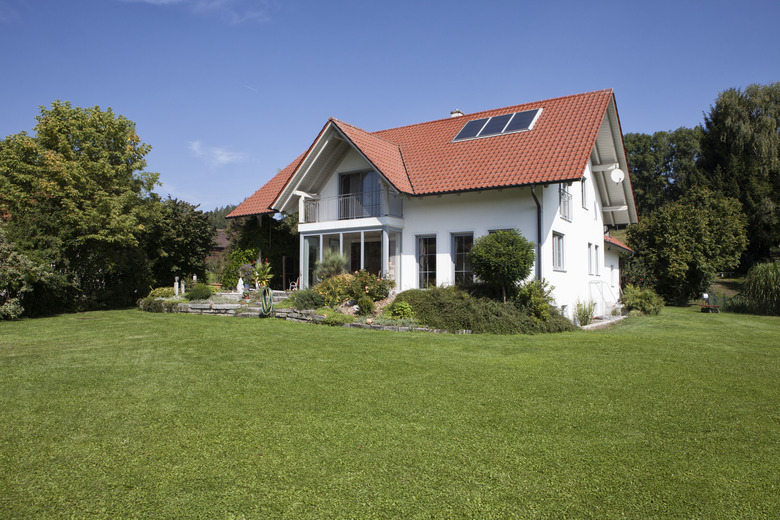How To Grow Grass In Sandy Soil
We may receive a commission on purchases made from links.
The deep green expanse of grass that covers the otherwise bare soil in your landscape adds value and beauty to your home. While quick-draining soils have their advantages, there are also disadvantages when you grow grass on sandy soil. Grass needs water and nutrients to thrive, so your sandy soil probably needs organic matter and fertilizer to ensure the lush green lawn of your dreams.
Grow Grass on Sandy Soil
Grow Grass on Sandy Soil
Sandy soils are made up primarily of sand particles, which are larger than the particles that are predominant in clay or silt soils. Because water drains away quickly from the relatively large spaces between the sand particles, sandy soils dry out quickly, and they also don't retain soil nutrients as effectively as denser clay and silt soils. In some ways, however, sandy soils have an advantage over heavier soils. Sandy soil is easier to work, and plant roots can more easily grow through the soil.
The ideal soil composition for lawn turf grass consists of 70 percent sand, 15 percent clay and 15 percent silt. Any soil with sand content above 50 percent is considered to be "sandy soil," so many sandy soils are actually well suited to growing turf grass. Sandy soils drain quickly, so they're also less prone to problems with standing water, which can injure or kill turf grass.
Grass Varieties for Sandy Soils
Grass Varieties for Sandy Soils
Some turf grass species are especially well adapted to growing on sandy soil. Several warm-season grasses, which are most often used in lawns in warmer climates, are able to grow well in the sandy soils prevalent in much of the South. These species include bahiagrass (Paspalum notatum, USDA zones 7-11), centipedegrass (Eremochloa ophiuroides, zones 7-8), carpetgrass (Axonopus affinis, zones 8-9) and St. Augustine grass (Stenotaphrum secondatum, zones 8-10).
Among cool-season grasses suitable for lawns in colder climates, Kentucky bluegrass (Poa pratensis, zones 3-7) is able to grow in sandy loams with sand content above 50 percent. The fine fescues (Festuca spp., zones 3-7) also thrive in sandy soils.
Sandy Soils and Amendments
Sandy Soils and Amendments
Sandy soils can usually benefit from the addition of organic material, such as well-decomposed compost, aged manure, ground bark, or peat moss, which will help the soil to retain both moisture and nutrients. Incorporating 2 inches of organic material into the top 6 inches of the soil before sowing the grass seed will significantly improve the texture of soils with a high sand content.
In addition, when you mow the lawn, leave the clippings to decompose. They return their nutrients to the soil and reduce the amount of fertilizer needed to nourish the grass.
Sandy Soils and Fertilization
Sandy Soils and Fertilization
Turf grass grown on any type of soil will benefit from the regular application of fertilizer, but sandy soils may require even more fertilization to make up for their lack of nutrient-holding ability. In general, you should fertilize new turf more often than established grass — generally, once a month during the growing season with a balanced dry fertilizer at a rate of 1 pound of nitrogen per 1,000 square feet of lawn, so, for example, a 10-10-10 fertilizer should be applied at a rate of 10 pounds per 1,000 square feet. Sandy soils should get an additional pound per 1,000 square feet of nitrogen-only fertilizer in between applications of the balanced fertilizer to establish new turfgrass.
Safety Precautions With Lawn Care
Safety Precautions With Lawn Care
Be sure to put on safety gear when working with soil, compost, manure, fertilizer and other amendments. Safety goggles, gloves, closed-toe shoes and a dust mask are among the essentials to protect your eyes, skin and lungs.
When spreading fertilizer over the lawn, avoid scattering it on sidewalks, driveways and other hardscapes. Sweep up the granules and toss them back on the lawn. Don't wash leftover fertilizer down the storm drains; the excess nitrogen encourages algae bloom in waterways, which leads to dead zones in rivers, lakes and the ocean due to the decomposition of the algae when it dies.
